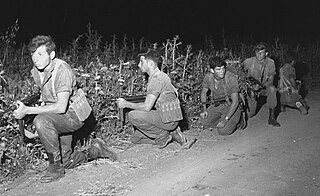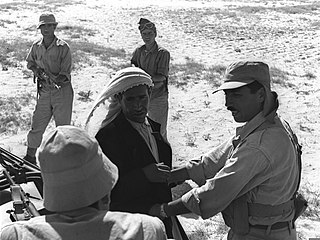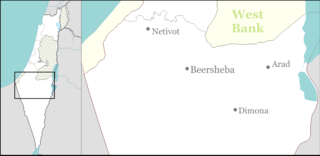| |||||
| Decades: | |||||
|---|---|---|---|---|---|
| See also: | |||||
Events in the year 1956 in Israel.
| |||||
| Decades: | |||||
|---|---|---|---|---|---|
| See also: | |||||
Events in the year 1956 in Israel.
| | This section needs expansion. You can help by adding to it. (August 2010) |

The most prominent events related to the Israeli–Palestinian conflict which occurred during 1956 include:
Notable Palestinian militant operations against Israeli targets
| | This section needs expansion. You can help by adding to it. (August 2010) |
The most prominent Palestinian fedayeen terror attacks committed against Israelis during 1956 include:
Notable Israeli military operations against Palestinian militancy targets
| | This section needs expansion. You can help by adding to it. (December 2010) |
The most prominent Israeli military counter-terrorism operations (military campaigns and military operations) carried out against Palestinian militants during 1956 include:
| | This section is empty. You can help by adding to it. (August 2010) |

Commando Unit 101 was a sayeret (commando) unit of the Israeli Defense Forces (IDF), founded and commanded by Ariel Sharon on orders from Prime Minister David Ben-Gurion in August 1953. They were armed with non-standard weapons and tasked with carrying out retribution operations across the state's borders—in particular, establishing small unit maneuvers, activation and insertion tactics.
This timeline of the Israeli–Palestinian conflict lists events from 1948 to the present. The Israeli–Palestinian conflict emerged from intercommunal conflict in Mandatory Palestine between Palestinian Jews and Arabs, often described as the background to the Israeli–Palestinian conflict. The conflict in its modern phase evolved since the declaration of the State of Israel on May 14, 1948 and consequent intervention of Arab armies on behalf of the Palestinian Arabs.

The Qibya massacre occurred during Operation Shoshana, a reprisal operation that occurred in October 1953 when Israeli troops under future prime minister Ariel Sharon attacked the village of Qibya in the West Bank, which was then under Jordan's control, and killed Palestinian civilians.

Moshe Dayan was an Israeli military leader and politician. As commander of the Jerusalem front in the 1948 Arab–Israeli War, Chief of Staff of the Israel Defense Forces (1953–1958) during the 1956 Suez Crisis, and especially as Defense Minister during the Six-Day War in 1967, he became a worldwide fighting symbol of the new state of Israel.
Fedayeen[note A] is an Arabic term used to refer to various military groups willing to sacrifice themselves for a larger campaign.
The history of the Israel Defense Forces (IDF) intertwines in its early stages with history of the Haganah.
This page is a partial listing of incidents of violence in the Israeli-Palestinian conflict in 2004.

Palestinian return to Israel refers to the movement of Palestinians back into the territory of present Israel.

Palestinian fedayeen are militants or guerrillas of a nationalist orientation from among the Palestinian people. Most Palestinians consider the fedayeen to be "freedom fighters", while most Israelis consider them to be "terrorists".
The 1952 raid on Beit Jala was a part of the reprisal operations that were carried out by Israel in response to Arab fedayeen attacks from across the Green Line. It involved an Israeli incursion into Beit Jala, a town in the Jordanian-annexed West Bank, on 6 January 1952, after which three houses were rigged with explosives and subsequently blown up; the attack killed seven civilian residents. After the attack, the perpetrators left leaflets at the site that were written in Arabic and explained the nature of the killings as a "penalty" for the earlier rape and murder of an Israeli Jewish girl by Palestinian Arab infiltrators, who were supposedly locals of Beit Jala, in the neighbourhood of Bayit VeGan in Jerusalem.

Reprisal operations were raids carried out by the Israel Defense Forces in the 1950s and 1960s in response to frequent fedayeen attacks during which armed Arab militants infiltrated Israel from Syria, Egypt, and Jordan to carry out attacks on Israeli civilians and soldiers. Most of the reprisal operations followed raids that resulted in Israeli fatalities. The goal of these operations – from the perspective of Israeli officials – was to create deterrence and prevent future attacks. Two other factors behind the raids were restoring public morale and training newly formed army units. A number of these operations involved attacking villages and Palestinian civilians in the West Bank, including the 1953 Qibya massacre.
Events in the year 1955 in Israel.
Events in the year 1954 in Israel.
Events in the year 1953 in Israel.
The Yehud attack was an attack on a civilian house in the village of Yehud carried out by a Palestinian fedayeen squad on 12 October 1953. Three Israeli Jewish civilians, a mother and her infant children, were killed in the attack.

The Negev desert road ambush was a terrorist attack which occurred on Thursday, 4 October 1956 at Highway 25, Israel when a squad of 10 armed Palestinian fedayeen fired at two civilian vehicles. As a result, 5 Israeli civilians were killed and 1 was injured.

Operation Black Arrow was an Israeli military operation carried out in Gaza on 28 February 1955. The operation targeted the Egyptian Army. Thirty-eight Egyptian soldiers were killed during the operation as were eight Israelis.

The Khan Yunis massacre took place on 3 November 1956, perpetrated by the Israel Defense Forces (IDF) in the Palestinian town of Khan Yunis and the nearby refugee camp of the same name in the Gaza Strip during the Suez Crisis.

The Palestinian Fedayeen insurgency was an armed cross-border conflict, which peaked between 1949 and 1956, involving Israel and Palestinian militants, mainly based in the Gaza Strip, under the nominal control, of the All-Palestine Protectorate – a Palestinian client-state of Egypt declared in October 1948, which became the focal point of the Palestinian fedayeen activity. The conflict was parallel to the Palestinian infiltration phenomenon. Hundreds were killed in the course of the conflict, which declined after the 1956 Suez War.